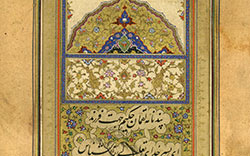Symmetry
Symmetry is a common aspect of Islamicate arts, but at times slight varieties are embedded in seemingly symmetrical pieces, either for the sake of variety itself or because differing sizes of letters and words, which are out of the control of the artist, would disrupt the symmetry of the page. As such, despite their symmetrical appearance, there is rarely perfect symmetry in these works.
Tazhib
The art of illuminating manuscripts or the borders of calligraphic works is called tazhib. It is derived from the Arabic word for gold, dhahab, and it usually requires using gold. Tazhib, however, is not exclusively in gold. Other colors such as white, red, azure, etc. are also used. Tazhib drawings, which have a long history, are not naturalistic drawings; rather they are based on the imagination of the artist and are thus regarded as a distinct form of drawing.
Tazhib can be understood as a specific kind of gilding, but there are two ways in which gold was employed in the traditional art of bookmaking in Iran. In one, gold papers, which were extremely thin and brittle were used to cover all or part of the surface of a page. In the other, gold was used in liquid solutions for drawing or for writing, as in the case of tazhib. The following is the traditional method used for making gold solutions. A small piece of gold was placed between two pieces of leather, and hammered for a long time until a very thin layer of gold was produced. Then, the thin layer of gold was ground in a container with gum arabic or another type of adhesive material that produced a gold solution, which was then used as ink for writing, drawing, or creating borders.




